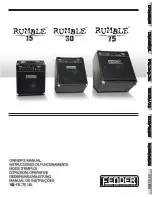
where P
equiv
is the equivalent power on the 8 ohm
speaker and V
rms
is the RMS voltage value calculated at
step 1. In this example (4 ohm speaker) this is 250 W.
This is the threshold power to set in the limiter.
The time constants for the Power vs voltage @ 8 Ohm limiter
can be set in the same way as for the TruePower limiter.
•
Power vs current @ 8 ohm: similar to the case
power vs voltage @ 8 ohm, but based on the current
measured at the output.
In this case the formula to derive the average or continuous
power, known as P
rms
from the RMS current is:
where I
rms
is the RMS current.
This limiter is particularly useful in situations where the
parameter to be controlled is the output current (e.g. for
tweeters).
It is also useful for special applications such as large coil
speakers with current controls. When determining this lim-
iter’s parameters, it is necessary to take into account the
number of speakers connected in parallel to the amplifier.
The power limiter menu allows to set the following
parameters:
•
Mode: allows to determine the power limiter
•
OFF/ON: toggle le limiter on or off;
•
TruePower: sets the limiter mode to TruePower
•
Power vs V @ 8 �: sets the limiter mode to Power vs
voltage @ 8 ohm
•
Power vs I @ 8 �: sets the limiter mode to Power vs
current @ 8 ohm
•
Soft knee: toggle ON/OFF
•
Thresh.(W): threshold output power level expressed in
watt at which the gain begins to be reduced;
•
Attack (ms): the time it takes for the limiter to start re-
ducing the amplifier gain once the output power has
exceeded the threshold value;
•
Release (ms): the time constant after which the gain is
restored to its nominal value once the output power has
returned below the threshold.
When editing the power threshold value, the display shows
the gain reduction (GR) in dB enforced by the combined
effect of the peak and power limiters. This information,
together with the average power truly delivered to the load
(P
avg
), is displayed in real time to allow monitoring of the limit-
ing actions as they are performed.
9.11.7 Damping Control
This unique and patented feature allows to add a “virtual”
series resistor to the amplifier output. This is done to obtain
the desired damping factor with any cabling used. For this
end, the virtual series resistor can also have a negative value
to compensate cabling resistance.
For example, using a 10 meter cable to powering the
subwoofer means adding a series parasitic resistance of
about 0.3 Ohms. By enabling the damping control, a virtual
negative series resistance can be added to compensate the
cable resistance.
When damping control is enabled, a lowpass filter
cutting around 400 Hz is automatically inserted
into the amplifier chain. This feature is intended
to be used only for subwoofer applications.
does not take into account the real part of the power;
however, it has the advantage of being independent from
the number of cabinets linked together, just as a peak limiter.
Some attention is needed to set the power threshold. The
P
AES
can be used if it is available. If no other power rating is
declared, the P
rms
can be used as well; however, the RMS
parameter is a value related to the maximum manageable
power and not the real power. Proceed with caution because
the manageable power could be greater than the real power.
Some constructors declare the RMS power at the minimum
impedance point of the speaker; this, again, may lead to an
overestimation of the true power values the speaker can
handle. If no other values are available, the following rule of
the thumb can be used: the P
rms
can be estimated as 6 dB
below the peak power (¼ of the peak power).
In order to preserve the driver in the long term, once the
maximum power limit is decided upon, consider a power
reduction of up to 3 dB of that value.
In order to use this limiter correctly, it is important to
recalculate the equivalent power at 8 ohm. For example,
with an 4 ohm speaker with 500 W maximum RMS power,
the equivalent power at 8 ohm needs to be calculated as
follow:
1. calculate the RMS voltage value needed to generate
the maximum RMS power on the 4 ohm speaker:
P
eqiv
=
8
V
2
rms
P
rms
= I
2
rms
∙
Re
V
rms
= √
Re
∙
P
rms
where V
rms
is the RMS voltage of the speaker, P
rms
is
its average or continuous power and Re the nominal
impedance. In the above example the RMS voltage of
the 4 ohm speaker is V
rms
= 44.7 V.
2. calculate the power delivered to a speaker with
nominal impedance of 8 ohm with that V
rms
voltage:
Bias Series User Guide V1.0
Page 22
















































